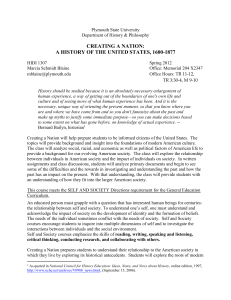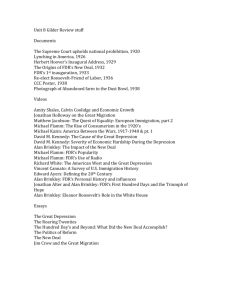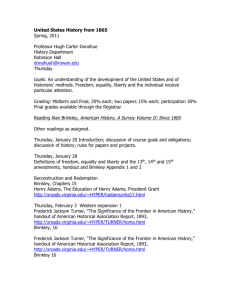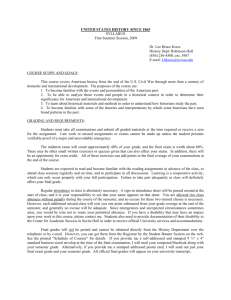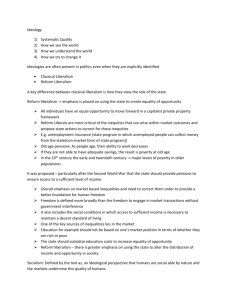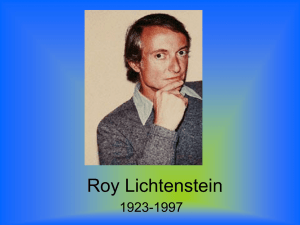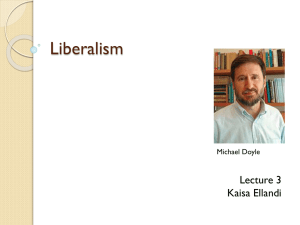Historiography Sample
advertisement
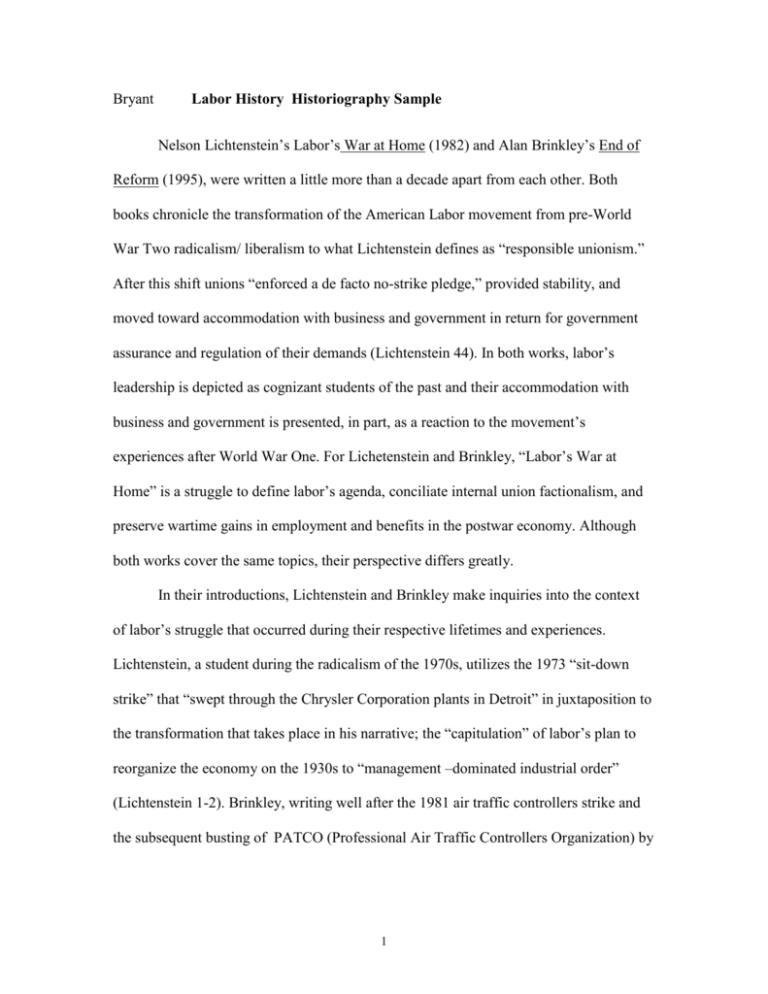
Bryant Labor History Historiography Sample Nelson Lichtenstein’s Labor’s War at Home (1982) and Alan Brinkley’s End of Reform (1995), were written a little more than a decade apart from each other. Both books chronicle the transformation of the American Labor movement from pre-World War Two radicalism/ liberalism to what Lichtenstein defines as “responsible unionism.” After this shift unions “enforced a de facto no-strike pledge,” provided stability, and moved toward accommodation with business and government in return for government assurance and regulation of their demands (Lichtenstein 44). In both works, labor’s leadership is depicted as cognizant students of the past and their accommodation with business and government is presented, in part, as a reaction to the movement’s experiences after World War One. For Lichetenstein and Brinkley, “Labor’s War at Home” is a struggle to define labor’s agenda, conciliate internal union factionalism, and preserve wartime gains in employment and benefits in the postwar economy. Although both works cover the same topics, their perspective differs greatly. In their introductions, Lichtenstein and Brinkley make inquiries into the context of labor’s struggle that occurred during their respective lifetimes and experiences. Lichtenstein, a student during the radicalism of the 1970s, utilizes the 1973 “sit-down strike” that “swept through the Chrysler Corporation plants in Detroit” in juxtaposition to the transformation that takes place in his narrative; the “capitulation” of labor’s plan to reorganize the economy on the 1930s to “management –dominated industrial order” (Lichtenstein 1-2). Brinkley, writing well after the 1981 air traffic controllers strike and the subsequent busting of PATCO (Professional Air Traffic Controllers Organization) by 1 the Reagan Administration, is further removed from the radicalism described by Lichtenstein. In contrast, Brinkley provides a structured and settled approach, firmly asserting three definitions of liberalism in relation to unionists’ struggles: liassez-faire, progressive, and individual and civil rights based. These definitions correspond with the shifting reality of the movement and provide a chronological context and model that emphasize the goal of the work- charting the differences that occurred between the 1930s and 1945 that altered the ideology of American liberalism. In Brinkley’s work, New Deal liberalism is but a brief moment in the evolutionary process of liberalism. These are not the only or most significant points of departure for these two works; however, it significantly separates them. While both works lament labor’s accommodation, the reader is given the sense that Lichtenstein views the CIO leadership as sellouts to labor’s prewar agenda (a view that is wedded to the period the book was written in). Brinkley traces the shift of liberal ideas and celebrates its move toward individual rights that most successfully surfaced in the Civil Rights Movement. Lichtenstein’s thesis is that tensions within the labor movement worked dialectically with business during the war causing a shift in government policy, altering the organization of labor’s politics and creating a space for social stability through labor’s accommodation with business. Labors struggle at home is not only with the outside forces of business and government, but its own internal struggle occurring between rankand-file local leadership and national leadership. The lion’s share of the book is dedicated to development of this struggle emphasized through the examples of the UAW and CIO. As CIO leaders embrace their relationship within the Roosevelt administration, the idea 2 of shop floor stability coupled with the patriotic fervor for the war effort coopted conservative labor leaders into the fold of business and government- “Equality of Sacrafice.” As a result, the CIO capitulates premium wages and the forty hour work week under pressure from the administration that is justified by the need for war production (Lichtenstein 95-98). In the end, the CIO leadership of Phillip Murray and Walter Reuther take a conservative stance distancing themselves from the tactics of John Lewis. Brikley’s thesis is that the experiences of World War Two moved labor away from its “hostility to capitalism and the corporate world” and its attempt in the 1930s to restructure and reform the inner workings of the economy to accommodation with business and the governments that resulted in a refocusing of liberalism toward individual liberties and civil rights (Brinkely 7). Brinkley’s contextual definition of three strains of liberalism is essential to understanding his model. First, “at the beginning of the century” it referred to “a belief in economic freedom” characterized by the limited government of laissez-faire. Next, in the early part of the twentieth century came a response to laissezfaire in the form of the progressive movement. Although there was no one agenda amongst the progressives, their movement is generally defined as protecting individuals from excessive corporate and government power and protecting the general welfare. Finally, and central to the thesis, is what emerged after the New Deal. In this new liberalism, emphasis was placed on individual rights and extending civil rights to groups excluded from the mainstream (Brinkley 8-10). What transpired during the war years was a move away from the second type of liberalism to the third. The term reform in the title is never suitably defined by the author, and the reader is left to draw his/her own 3 conclusion. The reform that ensued was less concerned with reorganizing the capitalist system and thus moved to individual rights within that system. This is better defined not as the end of reform, but rather a realignment of reform emphasis. For Brinkley, the critical turning point in the shift of liberalism came on the heels of the 1937 economic recession. Roosevelt’s 1936 landslide victory had appeared to be a mandate from the people (Brinkley 16-17). Bolstered by the President’s liberal advisors, the administration wanted to pursue progressive policies. Roosevelt initiated a plan to restructure the Supreme Court that was criticized by many as the actions of a dictator. Coupled with the ensuing economic crisis, it allowed conservatives to attack his administration. Further, Roosevelt inaugurated a plan to reorganize the executive branch that was met with the same disdain for its seeming abuse of power. Rather than reorganize the Supreme Court or executive branch, it resulted in the loss of power the President had exercised as a result of the election and the reorganization of his administration’s focus on reform. Coupled with the economic crisis, Brinkely asserts, that the “bleak winter of 1937-38 produced not just a severe recession, but an intense ideological struggle…to define the soul of the New Deal” (Brinkely 16-30). The new ideological struggle caused a shift in Roosevelt’s advisors and a shift from an emphasis on production to consumerism of Keynesian economics (Brinkley 6670). In this view, government was responsible for stimulating demand. Brinkley presents this ideological shift within the administration not as immediate, but rather as an evolutionary process of thought. Central to fostering this ideological shift was Marriner Eccles who was given further credence through Leon Henderson’s ability to give “the spending argument an intellectual respectability (Brinkley 77-84). What emerged from 4 the new emphasis on consumerism and the wartime economic boom was the need to increase industrial stability through greater cooperation between government agencies, business, and the conciliation of conservative labor leaders in an effort to maintain wartime gains. In tracing labors accommodation with government and business, Sidney Hillman is cited as creating labors future. It was Hillman’s emphasis on the CIO’s Political Action Committee that provided “a much more accurate barometer of the future course of the movement” ( Brinkley 222). In Hillman’s view, labor had to shed the “self-defeating independence and radicalism of working class politics and make labor a permanent ally of the Democratic party and the emerging consumer oriented liberal order they hoped it would represent” ( Brinkley 223). By 1945, the labor movement had moved far from the days of “militant, crusading workers promoting advanced, often radical, approaches to economic reform.” It had moved to its “modern form of highly bureaucratized (and occasionally corrupt) interest group, with relatively narrow (and at times illiberal) aims, committed mainly to its own institutional survival” (Brinkley 224). Brinkley asserts that the New Deal does not appear as a “bright moment” but part of long process of ideological change. It did not “reshape capitalist institutions,” rather, it “reshaped the economic and social environment in which those institutions worked” (Brinkley 268). In addition, Brinkley lists eight factors that led to the reconstruction of New Deal liberalism: 1. Failures and unintended consequences of some refrom efforts of the 1930s 2. Impact of recession of 1937-38 3. Frustrations the unexpected economic crisis had created, and the reassessments it had inspired 4. Emergence of a new set of economic ideals- chiefly identified with John Maynard Keynes- that provided an alternative to institutional approaches 5 5. 6. 7. 8. Dramatic economic growth of the 1940s Experience of wartime economy and mobilization Resurgence of popular conservatism Growing fear of totalitarianism (Brinkley 266-267). Both works utilize an impressive list of sources. Brinkley relied on manuscripts and archival sources, as well as published sources. Lichtenstein incorporates both published and primary sources as well; many of the items cited are UAW journals. A note of criticism. Given the detailed account present in both books, footnotes would have greatly added to the strength of the argument, validity, and overall comprehension. Going to the end of the work to discover sources only served to break the continuity of both narratives, not enhance them. Missing from both of these works is an emphasis on ethnicity, AfricanAmericans, or women in the work force. There is little mention of how the transformations occurring within the labor-movement, business, and government impacted these groups and the extent to which they participated and help shape the direction of various changes. Both Brikely and Lichtenstein are pigeonholed by their interpretive models when it comes to illustrating how the factors or ethnicity, gender, and race factored in labor’s struggle. Both works are intent on chronicling labor’s cooperation with bureaucratic Alphabet Soup agencies of the Roosevelt era and the resulting bureaucratic character of the CIO. As a result, Brinkley who defines the shift of liberalism as moving toward individual civil rights at the war’s end, contradicts himself in writing that “the most controversial government agency during the war was the Office of Price Administration, which infringed on personal liberty more directly than any other” (Brinkley 160). Reviewer Richard Polenberg, aptly asserts that in Brinkley’s emphasis on OPA he failed to take into account the War Relocation Authority’s 6 interment of Japanese Americans as the most egregious violation of civil liberties (Polenberg 174). Similarly, Lichtenstein, in the chapter entitled, “Holding The Line,” cites John Lewis as the alternative for the rank-and-file who support a repeal of the no-strike pledge, resistance to incentive pay, and reassertion of union power on the shop floor. As a result, the UAW “began to emulate Lewis’ strike militancy” and “coinciding with the nationwide coal strikes, a wave of major wildcats swept through Detroit, Akron, and the east coast shipyards” in the spring of 1943 (Lichtenstein-163). While an internal factionalism played out between CIO leaders and Lewis for control and loyalty of the rank-and-file, race tensions flared in Detroit. In John Hope Franklin’s From Slavery to Freedom: A History of Negro Americans, the war era is depicted as the golden age of black employment. In his work, Franklin captured the tensions between black and white workers in Detroit on June 20,1943 that resulted in the “most serious race riots of the war period.” When local authorities were incapable of ending the violence Roosevelt “proclaimed a state of emergency and sent six thousand soldiers into patrol the city” (Franklin 403). Although strikes in major cities had subsided, by “mid-June” Congress “overrode FDR’s veto to pass the long- simmering Smith –Conally War Labor Disputes Acts.” The “new law was above all the hard slap at the union movement that the Dixiecrat-Republican forces had sought to deliver since the 1930s” (Lichtenstein-167). Given this background, the reader is left to wonder to what extent race factored in the conservative block of Congress’formed by Dixiecrat-Republican forces- decision to move ahead on the Smith-Conally Act. The structural model of both books are sensitive to the issue of race, but effectively 7 marginalize the subject. No book can capture every social, political, and economic force at work. These works do succeed in achieving their central goals- tracing this shift of liberalism within the labor movement from its prewar radicalism to its postwar conservatism and accommodation. 8 Works Cited Brinkley, Alan, The End of Reform: New Deal Liberalism in Recession and War New York: Alfred A. Knopf, 1995. Franklin, John Hope, From Slavery to Freedom: A History of Negro America New York: Magraw-Hill Inc., 1988. Nelson, Lichtenstein, Labor’s War at Home: The CIO in World War II New York: Cambridge University Press, 1982 Polenberg, Richard, “Review End of Reform” Political Science Quarterly Vol 111 (1) (Spring, 1996): 174-175. 9 10
